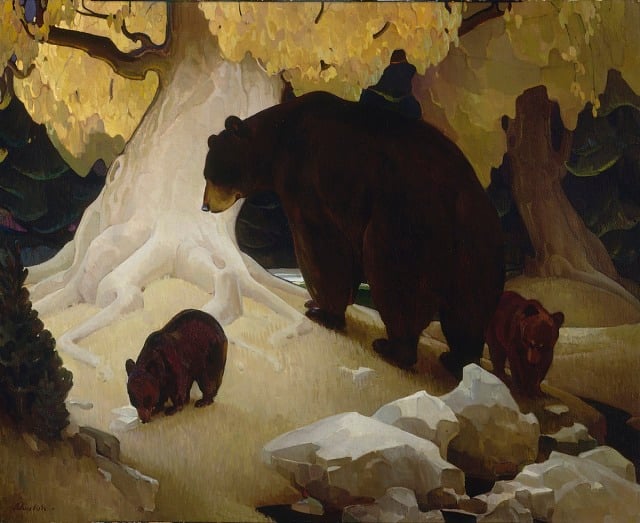by Geoffrey Clarfield (April 2025)

David said, “The Lord who delivered me from the paw of the lion and from the paw of the bear will deliver me from the hand of this Philistine. —1 Samuel 17:37
For Geza Teleki and my brother Mark … because they know why.
Abner Miller opened the door and walked out of his house in the Kawarthas. He strolled to the end of the driveway and looked at his old fashioned post office box. He opened the clasp, stuck in his hand and pulled out the mail.
Bills, advertisements for portable pools, eavestrough cleaners, handymen and real estate brochures. “Buy your luxury cottage on Buckhorn Lake. Asking price, One Million Dollars!” Prices had skyrocketed recently and cottages on the water that once went for four hundred thousand had doubled, tripled during this year of Covid.
One hundred and fifty thousand people had left Toronto, mostly young families who could work online and wanted quality of life for their growing families in towns like Lindsay or outside of the city, on forested roads or waterfront. It was changing the face of the Kawarthas.
Before the invasion of the city folk, it used to be there were only four or five kinds of people out there and they had managed to set up a kind of unconscious social mosaic that allowed everyone to get along. But things were changing now. So much so that the wildlife that had been left alone for decades if not centuries, was invading towns, villages and cottage country, but more on that later.
First, there were the wealthy cottagers from Toronto who stuck to themselves and each other and bought the goods and services on offer from the “locals;” farmers, artisans, carpenters, gardeners, plumbers and electricians, even local builders. The artisans did well, worked hard from May to October and then spent a quiet winter ice fishing, hunting and riding their skidoos.
Then there were the horsey people with their ranches and stables. Some local and some imported and some linked into neighbouring horsey Uxbridge county whose upper class clients, from Upper Canada College (UCC) and Branksome Hall learnt Olympic jumping on weekends and holidays. Then they went back to their houses in Rosedale and their sailing berths at the Royal Yacht Club on Toronto Island.
Then there were the farmers, a tight and suspicious bunch, marrying one another, passing down farms, going to schools on school buses and keeping everyone well fed. They even spoke differently, a kind of down home clipped English which made you want to imagine them smoking corn cob pipes on their verandas and reading Frank Baum stories, but that would be in the US south of the border. You get the gist though.
Then there were the townies, doctors, lawyers and people who owned restaurants and hardware stores, sprinkled with posh antiques sellers from Ottawa and even Montreal and Europe, selling dead people’s stuff for five times what it was once worth.
And of course, there were the simple working people, Anglo Canadians, largely Protestant but with a fair number of Catholic Irish whose faces could have come off the streets of 19th century London. They liked Country and Western Music and recently some had become Evangelicals. Most of them were poor and struggling. Some were on welfare.
So how can you tell me you’re lonely
And say for you that the sun don’t shine
Let me take you by the hand and lead you through the streets of London
I’ll show you something to make you change your mind
These Anglos were the left behinds. Their elites in Toronto and Ottawa and the big cities no longer cared for them and preferred to invite wealthy industrialists from all over the world, everywhere but the UK, to come to Canada’s cities and change the face of the nation. If the locals protested, well they were simply racists.
Then there were the Indians. Their names had changed a lot since Abner grew up. First they were Indians, then they were First Nations, then Indigenous Peoples and now each group wanted to be called by their own name in their own language which almost universally meant “the people.”
A troubled bunch, traumatized, angry, with lots of drug problems, band corruption and social breakdown, trying to live collective lives and failing as individuals. Here and there a few managed to make a compromise, speaking Ojibwa, going to the sweat lodge, pow wows, hunting, fishing and telling tall tales which made them laugh heartily. Grey Owl would have felt at home among this saving remnant. Some of them were Abner’s friends and colleagues. One or two had kept up the indigenous knowledge and tales of the plants and animals of the region which kept Abner awake and alert when they were doing fish counts and the like on the lakes and rivers of the Kawarthas.
Abner had learnt by heart part of the creation story and would recite the lines out loud when walking in the forest alone, making sure the bears heard every word and who would leave him alone because he was so noisy.
Pii we ki gaa-wshkiniigwang, gii-nngodoodemgiziimgad. “Nookmisnaan” n’di-zhnikaanaamin wedi Dbik-giizis. “Nmishoomsinaan” n’di-zhnikaanaamin wedi Giizis. Gaa-zhi-nwendiwaad gowenwag n’swi, mii gaa-wnjiimgak kina gegoon maawndi kiing. Mii we gaa-zhitood Gzhe-mnidoo. Kwewid we Mzakmig-kwe kidnaanwan. Jibwaa-wzhichgaaznid ninwan, gii-bi-yaa ntam we Mzakmig-kwe. Kina gaa-bmaadziwaad wgashktoonaawaa wii-bmaadziwaad Mzakmig-kwewan wnji. Wdoo-mskwiim, mii gaa-aawang nbi. Aabjijwan dash Mzakmig-kweng ji-bmaadzid gye wiin miinwaa ji-biinaabaawnind.
When the Earth was young, it had a family. The Moon is called Grandmother, and the Sun is called Grandfather. This family is basis of all creation in the universe. This family was created by Gitchi Manitou, the Creator. Earth is said to be a woman. She preceded man and her name is Mother Earth because all living things live from her gifts. Water is her life blood. It flows through her, nourishes her, and purifies her.
Mother Earth, was given Four Sacred Directions—North, South, East, and West. Each direction contributes a vital part of her wholeness. Each direction and all things on Mother Earth have physical powers and spiritual powers
The Indians had suffered, without a doubt. Their land treaties had only been finalized in 1923, within the living memory of Abner’s grandfather and for them that was recent enough and legal enough for them to be fighting for an expansion of their land rights, in an infinite and growing concentric circle which could, if logic was the basis of all things include all of Ontario, except before the French and the British came they were few on the land, fought with each other brutally and did not have a modern concept of land tenure. They got that from the Brits. We got canoes from them.
Then there were his people, the Amish, traditionalist descendants of German speaking Protestants who believed that God wanted them to live in near 19th century circumstances, have big families, avoid the ways of the wider society, left alone to farm, pray and stay away from temptation. These were his people and he had left them.
Abner looked across the road and as far as the eye could see he saw thick forest, so thick that it was dark inside, unchanged since the time of the Indians. He knew the name of every species of tree and could distinguish the species and sub species of the birch and evergreens which comprised the forest and the ferns and flowers to be found at the forest edge. It was autumn and distinct species changed colours on a daily basis until the trees were bare and you could see for long distances through the forest with its leafless skeletons.
Today he saw evergreens that did not change colour and then others whose leaves had turned bright red, orange, light green, even pink and yellow, and although there was no wind, they fell and fluttered to the ground, as if an invisible hand was plucking them and throwing them down, as if giant tea pickers were ridding the forest of its leaves. Abner spotted migrating wild geese, as well as cranes and blue jays in the air before he turned around to go back inside and sort through his mail.
His wife Emma served him up coffee and the fresh bread that gave the kitchen and dining room a heavenly aroma before the start of each working day.
Abner had left the Amish. It happened when he was eighteen. A keen naturalist, his parents and kin could not explain the secrets of nature to him. At a roadside sale he found a copy of the The Origin of Species by Darwin and that was the end of it. He broke with the Amish.
He left his parents’ house, moved to Peterborough, worked part time as a carpenter and studied biology and the history of science at Trent University, got a job with Lands and Forests and rose up the hierarchy. He was now the chief regional ecologist for the southern Kawarthas.
***
He was studying a patch of land that lay between the cottages and the farms, thick forest and swamp that had change little over the last 12,000 years since the last ice had melted, leaving behind moraines, forests and meadows which had survived almost pristine into the 21st century.
It was as thick at times as the forests of the Central Congo which he had once visited on a Canadian government study tour but he liked his own indigenous forest the best. It spoke to him and he could often hear the wolves and bears with their distinctive cries in his dreams. Emma would often wake him up as he imitated their sounds in his deep sleep.
There were a group of bears that lived in the forest and he tracked them. There were times that he used snowshoes to make sure he did not sink in the swamps. Times he tied lines to trees to make sure he did not get stuck and die in the mud. Times where even his government issue satellite phone did not work when there was too much cloud coverage. Abner was a survivalists’ survivalist. He carried enough gear, food and medicine to survive alone for two weeks in the forest if he got lost or injured or stuck.
Abner’s latest project was a manual for the ministry on Black Bears. He had just started it:
Black bears are large, heavily boned mammals. Adult males weigh from 120 kg to 300 kg (250-650 lbs.), and are 130 to 190 cm (4-6’) in length from the tip of the nose to the tip of the tail. Adult females are smaller, weighing from 45 to 180 kg (100-400 lbs.) and measuring 110 to 170 cm (3½-5 ½’) in length. Adult females reach maximum height and length at about five years of age. Adult males reach their maximum height and length when they are seven or eight years old (Kolenosky and Strathearn 1987a). Most black bears in Ontario have a black coat colour although a small proportion (less than five percent) are dark brown to light brown. Body weights of adult bears vary dramatically throughout the year, and from one year to the next, depending on food availability. In Ontario, adult bears lose weight from the time they enter the den in the fall until well after they emerge from the den in spring. In early July, berries and other soft fruits start to become available and adult bears begin to gain weight. When food is abundant, bears can gain up to 1 kg per day and can double their weight by fall.
Abner opened one of his letters from a colleague who was studying wolves. She wrote:
…Our German Shepherd was very agitated last fall and barked continuously right after sunset. She is an excellent guard dog and barks at Coyotes as they move through the area yipping and making a racket. This was different; she was very agitated. When we went outside to calm her down, we heard barks and howls that were definitely coming from a Wolf. Wolves have been sighted in our area—north east of Napanee along the Salmon River. I’ve seen Wolves in the past, but last fall there are many more sightings as well as people hearing them.
Abner thought to himself. Too many people. Not enough room for wild animals. “The conservationist’s conundrum,” he said to himself. He put on his knapsack, put his rifle around his shoulder and said goodbye to Emma. He started walking and two hours later, deep in the forest he found his observation tent.
It had everything he needed and he climbed the ladder on the tree and sat fifty feet above the forest with all his infrared gear, tape recorders, drones and other high tech stuff listening to the forest and watching out for wildlife. The sun shone brightly and he could see past the cottages out onto the blue waters of Lake Balsam.
He was looking for something unusual. There had been reports of a giant bear. It had been spotted by cottagers after the ice started breaking up. Fuzzy photos had been sent to his web site. He had received emails and letters, garbled reports. One read,
Dear Mr. Miller:
Last April my husband and I were sitting at the edge of the water as the ice was breaking on the lake. All of a sudden we heard a splash and saw an enormous bear paddling through the water. It must have been ten feet long. My husband got angry with me as he said that I see everything bigger when I do not wear my glasses. I put on my glasses and he took out his binoculars, cursed and yelled and said, “That is the biggest bear I have ever seen in my life!” He was shaking.
Abner got out his phone and read a recent download on megafauna, the giant mammals that had once inhabited north America until the arrival of the Paleo Indians a mere 12,000 years ago, a mere blink in the eye of biological time.
December 18, 2017 – Researchers from the Canadian Museum of Nature and the Natural History Museum of Los Angeles County have identified remains of a 3.5- million-year-old bear from a fossil-rich site in Canada’s High Arctic. Their study shows not only that the animal is a close relative of the ancestor of modern bears—tracing its ancestry to extinct bears of similar age from East Asia—but that it also had a sweet tooth as determined by cavities in the teeth.
The scientists identify the bear as Protarctos abstrusus, which was previously only known from a tooth found in Idaho. Showing its transitional nature, the animal was slightly smaller than a modern black bear, with a flatter head and a combination of primitive and advanced dental characters. The results are published today in the journal Scientific Reports.
This is evidence of the most northerly record for primitive bears, and provides an idea of what the ancestor of modern bears may have looked like.
The article then went on to say that similar as yet undiscovered fossil bears may have reached the height of twelve feet and may have died out a mere 12000 years ago. Abner pulled up an article about bear symbolism on his cell phone written by an anthropologist who had studied bears:
Irving Hallowell called attention to the widespread distribution of bear ceremonialism among boreal cultures of northern Eurasia and North America. He showed that reverence for the bear was governed primarily by sociopsychological factors of possible great antiquity. This study draws on Hallowell’s insights and uses a holistic approach to interpret bear imagery and ritual found in archaeological contexts for northeastern North America. Various data demonstrate the antiquity and variability of bear ceremonialism including the communal feasting of bear brains, ritual use of skull masks, public display of skulls in elevated positions, various expressions of symbolism in art, ritual disposal of post-cranial remains, and widespread distribution of bear clans with their associated rituals and leadership roles. Cross-culturally, the bear may signify a dangerous predatory animal opposed to humans while simultaneously looking and behaving like a person, thus representing a source of power as an other-than-human being.
Abner sat on his perch all day. Flocks of birds were moving south. He thought he could smell rain. Occasionally, he treated himself to a joint of marijuana but today he abstained. Then he heard the noise.
He could see it down below. It was lumbering towards his base camp. It came to the tent at the bottom of the tree and with one low paw swipe tore a whole in the side. It raided his food cache. It slashed his hanging barrels of dry goods which supplied his camp for the weeks that he was alone. It found a sealed cannister of honey and ripped it open with its jaws.
The giant bear roared in such a way that it made Abner’s hair stand on end. He felt a paralyzing fear come over him, one that he had never ever experienced in his life. The bear fell asleep at the bottom of the tree and stayed there for eight hours, dozing, rolling over and roaring. It stayed another eight and then another eight hours.
Slowly it started to move away. Abner came down from his perch and took out his hunting gun. He was two hours from the road and school buses dropped off children there twice a day. He feared that the bear was on his way to the road. He tracked the bear. He stalked it. He kept down wind. He followed its droppings and trail and then he saw it. The bear stood up and roared. He roared again and then started coming towards Abner. Abner had no choice.
He trembled. He was not sure what he was supposed to do. He told himself that he was a Canadian conversationist. “First do no harm,” he said to himself. He had watched David Suzuki. He and his wife had tried to go Vegan once out of conviction, but their desire for meat and its health benefits got the better of them.
The bear got closer and closer. Abner raised his gun. He aimed it between the bears eyes. He had always been a great shot and squeezed the trigger. He hit the bear between the eyes and it dropped dead, twenty feet away from him. He remembered the story of David and Goliath that he had been taught so many times in Sunday school when he was a devout son of the Amish. Although not devout, he made a spontaneous prayer of thanksgiving to God that had spared him to live another day.
Abner went over and inspected the bear. It was just like all the other bears he had studied except it was 12 feet tall. He had some vague scientific idea of what he had found, but was too dazed to quite figure it out. He walked to the road, made it home and asked his wife for a lift up the road to the head parks office.
He reported what he had found and done. His boss sent him home. He drank a half bottle of whiskey and slept for 24 hours. Soon after he was suspended from his job. The media had a field day with the discovery of Abner’s Bear, the prehistoric monster. He became the lightning rod for a dispute between scientists who hailed his discovery as a major contribution to paleo biology, and the media who conducted a witch hunt against this “toxic male” who shot first and talked later.
This was the new 21st century Canada where males are always wrong and you guilty until proven innocent. The tide only turned when in outrage over the treatment of Abner by his fellow countrymen, world famous British naturalist David Attenborough, after having read all the material on Abner’s discovery and “kill” managed to get the British Scientific Association to award Abner the Darwin Medal for biological discovery. It was sent to him by the Queen through the office of the Governor General of Canada and then, ever so slowly, ever so slowly, public opinion and the media moved in Abner’s favour beginning with a scathing oped by Rex Murphy.
Abner sued Parks Canada for defamation of character. The judge awarded him damages of 250,000 dollars. He was reinstated in his job and the newly discovered bear species was named Ursus Abnerensis. One year later Abner was given the Order of Canada for his world changing contribution to Canadian science and then he was also given the newly created Canada Medal for Conservation by the newly elected Prime Minister, Pierre Polievre.
Abner still lives in the same house and has the same job. He is happiest when he is up above the canopy and he believes there are other living bears like the ones he found. He knows they are out there and he wants to capture them, alive this time.
His friends among the Ojibwa are on the lookout for unusual animal behaviour and cottage country kids now all carry binoculars.
Abner is content. His wife recently gave birth to their first boy. His name is David.
Table of Contents
Geoffrey Clarfield is an anthropologist at large. For twenty years he lived in, worked among and explored the cultures and societies of Africa, the Middle East and Asia. As a development anthropologist he has worked for the following clients: the UN, the Rockefeller Foundation, the Norwegian, Canadian, Italian, Swiss and Kenyan governments as well international NGOs. His essays largely focus on the translation of cultures.
Follow NER on Twitter @NERIconoclast
- Like
- Digg
- Del
- Tumblr
- VKontakte
- Buffer
- Love This
- Odnoklassniki
- Meneame
- Blogger
- Amazon
- Yahoo Mail
- Gmail
- AOL
- Newsvine
- HackerNews
- Evernote
- MySpace
- Mail.ru
- Viadeo
- Line
- Comments
- Yummly
- SMS
- Viber
- Telegram
- Subscribe
- Skype
- Facebook Messenger
- Kakao
- LiveJournal
- Yammer
- Edgar
- Fintel
- Mix
- Instapaper
- Copy Link






